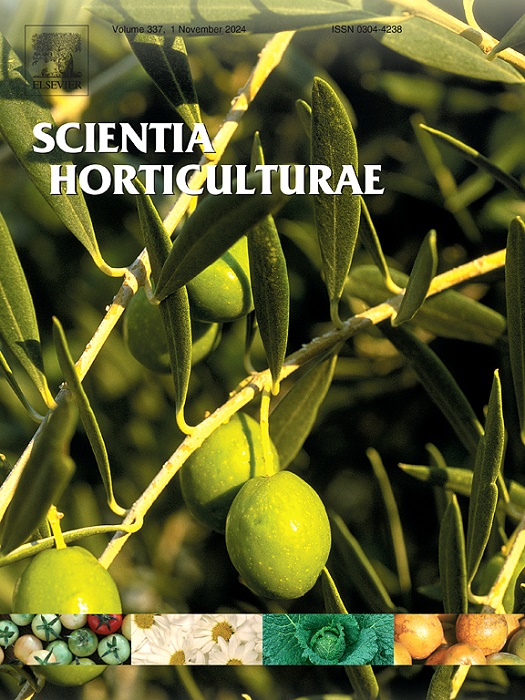Non-natural day length does not negatively affect lettuce growth as a result of acclimated carbohydrate rhythms
IF 3.9
2区 农林科学
Q1 HORTICULTURE
引用次数: 0
Abstract
The plant endogenous clock determines optimal physiological and growth responses to daily environmental changes. Aligning the day length with the endogenous clock period (different from 24 h) is known as circadian resonance and enhances the growth of Arabidopsis thaliana via precise timing of carbohydrate metabolism and a range of other physiological processes. Furthermore, long photoperiods within a 24 hour day enhance plant growth compared to short photoperiods. This study aimed to elucidate the interaction between day length and photoperiod on growth, and morphology, and how daily rhythms of non-structural carbohydrates explained these effects. We grew two lettuce cultivars in a climate chamber under day lengths of 20, 22, 24, 26 and 28 h combined with dark periods of 2, 4 and 6 h and under continuous light. Growth and morphology were unaffected by the interaction between day length and photoperiod, as well as by day length alone. Extending the photoperiod by reducing the dark period from 6 to 2 h did not affect growth in one cultivar, however, it improved growth in the other cultivar. This positive effect on growth was associated with higher leaf area and projected leaf area. Non-structural carbohydrates showed rhythms in agreement with the day length applied, which implies acclimation to non-natural days likely via endogenous clock regulation. Our findings show that a lack of circadian resonance does not necessarily result in poor growth and remark the benefit of extended photoperiods to achieve similar or enhanced growth compared to shorter photoperiods at equal DLI.
非自然日长对生菜生长没有负面影响,这是碳水化合物节奏驯化的结果
植物内源性时钟决定了对日常环境变化的最佳生理和生长反应。使白昼长度与内源性生物钟周期(不同于24小时)保持一致被称为昼夜节律共振,并通过精确定时的碳水化合物代谢和一系列其他生理过程来促进拟南芥的生长。此外,24小时内较长的光周期比短的光周期更能促进植物的生长。本研究旨在阐明日照长度和光周期对植物生长和形态的相互作用,以及非结构性碳水化合物的日节律如何解释这些影响。在连续光照条件下,白昼长度分别为20、22、24、26和28 h,暗期分别为2、4和6 h。日长和光周期的相互作用以及单独的日长均不影响植株的生长和形态。通过将暗期从6 h缩短至2 h来延长光周期,对一个品种的生长没有影响,但对另一个品种的生长有促进作用。这种对生长的积极影响与较高的叶面积和预计叶面积有关。非结构性碳水化合物显示出与所应用的白昼长度一致的节律,这意味着可能通过内源性时钟调节来适应非自然白昼。我们的研究结果表明,缺乏昼夜节律共振并不一定会导致生长不良,并注意到与同等DLI下较短的光周期相比,延长光周期可以实现类似或增强的生长。
本文章由计算机程序翻译,如有差异,请以英文原文为准。
求助全文
约1分钟内获得全文
求助全文
来源期刊

Scientia Horticulturae
农林科学-园艺
CiteScore
8.60
自引率
4.70%
发文量
796
审稿时长
47 days
期刊介绍:
Scientia Horticulturae is an international journal publishing research related to horticultural crops. Articles in the journal deal with open or protected production of vegetables, fruits, edible fungi and ornamentals under temperate, subtropical and tropical conditions. Papers in related areas (biochemistry, micropropagation, soil science, plant breeding, plant physiology, phytopathology, etc.) are considered, if they contain information of direct significance to horticulture. Papers on the technical aspects of horticulture (engineering, crop processing, storage, transport etc.) are accepted for publication only if they relate directly to the living product. In the case of plantation crops, those yielding a product that may be used fresh (e.g. tropical vegetables, citrus, bananas, and other fruits) will be considered, while those papers describing the processing of the product (e.g. rubber, tobacco, and quinine) will not. The scope of the journal includes all horticultural crops but does not include speciality crops such as, medicinal crops or forestry crops, such as bamboo. Basic molecular studies without any direct application in horticulture will not be considered for this journal.
 求助内容:
求助内容: 应助结果提醒方式:
应助结果提醒方式:


